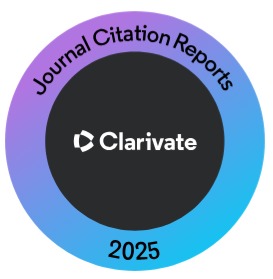Application of Biosensors in Diagnosis of Human Parvoviruses
Keywords:
Human Parvovirus B19, Biosensor, Molecular and Serological DiagnosisAbstract
Human parvovirus B19 is a viral pathogen that causes acute and usually self-limiting disease. Because the B19 virus predicates erythroid progenitor cells, it can cause a transient aplastic crisis in immunocompromised individuals. This infection has been associated with nonimmunologic fetal hydrops during pregnancy; also, B19 can persist for months in immunocompromised individuals. In B19 infection, viremia with a high titer is observed for approximately one week. After that, a specific immune response is critical to control the infection. Although molecular and serologic tests commonly diagnose the B19 virus, laboratory diagnostic tests have limitations. For the detection of human parvovirus B19, an inexpensive, effective, and rapid biosensor may be considered as an alternative.
Key Words: Human Parvovirus B19, Biosensor, Molecular and Serological Diagnosis.
References
Qiu J, Soderlund-Venermo M, Young NS. Human parvoviruses. Clin Microbiol Rev. 2017; 30(1): 43-113. doi: 10.1128/CMR.00040-16.
Heegaard ED, Brown KE. Human parvovirus B19. Clin Microbiol Rev. 2002; 15(3): 485-505.
Broliden K, Tolfvenstam T, Norbeck O. Clinical aspects of parvovirus B19 infection. J Intern Med. 2006; 260(4): 285-304. doi: 10.1111/j.1365-2796. 2006.01697.x.
Luo Y, Qiu J. Human parvovirus B19: A mechanistic overview of infection and DNA replication. Future Virol. 2015; 10(2): 155-67. doi: 10.2217/fvl.14.103.
Musiani M, Zerbini M, Gentilomi G, M Plazzi, G Gallinella, S Venturoli. Parvovirus B19 clearance from peripheral blood after acute infection. J Infect Dis. 1995; 172(5): 1360-3. doi: 10.1093/infdis/ 172.5.1360.
Zerbini M, Gallinella G, Cricca M, Bonvicini F, Musiani. Diagnostic procedures in B19 infection. Pathol Biol(Paris). 2002; 50(5): 332-8.
doi: 10.1016/s0369-8114(02)00308-5.
Hunter LA, Ayala NK. Parvovirus B19 in pregnancy: a case review. J Midwifery Womens Health. 2021; 66(3): 385-90. doi: 10.1111/jmwh. 13254. Epub 2021 Jun 8.
Mizumoto J. Parvovirus B19 Infection With Positive Rumpel-Leede Sign. Am J Med. 2020; 133(5): e195-e196.
Kostolansky S, Waymack JR. Erythema Infectiosum. In: StatPearls [Internet]. Treasure Island. (FL): StatPearls Publishing; 2022 Jan. Oct 30.
Nguyen HH, Lee SH, Lee UJ, Fermin CD, Kim M. Immobilized enzymes in biosensor applications. Materials (Basel). 2019; 12(1): 121. doi: 10.3390/ma12010121.
Zandi M, Zandi S, Mohammadi R, Hosseini P, Teymouri S, Soltani S et al. Biosensor as an alternative diagnostic method for rabies virus detection: A literature review. Biotechnol Appl Biochem. 2022; 69(4): 1348-53. doi: 10.1002/bab. 2207. Epub 2021 Jun 9.
Zandi M, Fani M. Target genes used for biosensor development in COVID-19 diagnosis. Biosens Bioelectronic. 2022; 200: 113924. doi: 10.1016/j.bios.2021.113924. Epub 2021 Dec 30.
Peterlana D, Puccetti A, Corrocher R, Lunardi C. Serologic and molecular detection of human Parvovirus B19 infection. Clin Chim Acta. 2006; 372(1-2): 14-23. doi: 10.1016/j.cca.2006.04.018. Epub 2006 Jun 9.
Kurtzman GJ, Cohen BJ, Field AM, Oseas R, Blaese RM, Young NS. Immune response to B19 parvovirus and an antibody defect in persistent viral infection. J Clin Invest. 1989; 84(4): 1114-23. doi: 10.1172/JCI114274.
Bluth MH, Norowitz KB, Chice S, Shah VN, Nowakowski M, Josephson AS et al. Detection of IgE anti-parvovirus B19 and increased CD23+ B cells in parvovirus B19 infection: relation to Th2 cytokines. Clin Immunol. 2003; 108(2): 152-8.
doi: 10.1016/s1521-6616(03)00098-6.
Di Paola N, Mesquita FS, Oliveira DB, Villabona-Arenas CJ, Zaki Pour S, de Sousa-Capra C, et al. An outbreak of human parvovirus B19 hidden by dengue fever. Clin Infect Dis. 2019; 68(5): 810-7. doi: 10.1093/cid/ciy630.
Seetha D, Pillai HR, Nori SR, Kalpathodi SG, Thulasi VP, Nair RR. Molecular-genetic characterization of human parvovirus B19 prevalent in Kerala State, India. Virol J. 2021; 18(1): 96. doi: 10.1186/s12985-021-01569-1.
Corcoran A, Kerr S, Elliott G, Koppelman M, Doyle S. Improved detection of acute parvovirus B19 infection by immunoglobulin M EIA in combination with a novel antigen EIA. Vox Sang. 2007; 93(3): 216-22. doi: 10.1111/j.1423-0410. 2007.00956.x.
Ramos-Vara JA, Kiupel M, Baszler T, Bliven L, Brodersen B, Chelack B et al. Suggested guidelines for immunohistochemical techniques in veterinary diagnostic laboratories. J Vet Diagn Invest. 2008; 20(4): 393-413. doi: 10.1177/10406 3870802000401.
Du J, Wang W, Chan JF, Wang G, Huang Y, Yi Y et al. Identification of a novel ichthyic parvovirus in marine species in Hainan island, China. Front Microbiol. 2019; 10: 2815. doi: 10.3389/fmicb. 2019.02815.
Singh S, Kumar V, Dhanjal DS, Datta S, Prasad R, Singh J (2020). Biological Biosensors for Monitoring and Diagnosis. In: Singh, J., Vyas, A., Wang, S., Prasad, R. (eds) Microbial Biotechnology: Basic Research and Applications. Environmental and Microbial Biotechnology. Springer, Singapore. https://doi.org/10.1007/978-981-15-2817-0_14Biological biosensors for monitoring and diagnosis.
Gergeroglu H, Yildirim S, Ebeoglugil MF. Nano-carbons in biosensor applications: an overview of carbon nanotubes (CNTs) and fullerenes (C 60). SN Applied Sciences. 2020; 2: 603.
Byrne B, Gilmartin N, Lakshmanan RS, O'Kennedy R. Antibodies, enzymes, and nucleic acid sensors for high throughput screening of microbes and toxins in food. In Book: High throughput screening for food safety assessment: Elsevier. 2015; 25-80.
Teklemariam AD, Samaddar M, Alharbi MG, Al-Hindi RR, Bhunia AK. Biosensor and molecular-based methods for the detection of human coronaviruses: A review. Mol Cell Probes. 2020; 54: 101662. doi: 10.1016/j.mcp.2020.101662.
Zhang D, Anderson MJ, Huarng MC, Alocilja EC. Nanoparticle-based bio-barcoded DNA sensor for the rapid detection of pagA gene of Bacillus anthracis. IEEE Transactions Nanotechnol. 2011; 10(6): 1433-8.
Afsahi S, Lerner MB, Goldstein JM, Lee J, Tang X, Bagarozzi DA et al. Novel graphene-based biosensor for early detection of Zika virus infection. Biosens Bioelectron. 2018; 100: 85-88. doi: 10.1016/j.bios.2017.08.051. Epub 2017 Aug 24.
Dong S, Zhao R, Zhu J, Lu X, Li Y, Qiu SH et al. Electrochemical DNA biosensor based on a tetrahedral nanostructure probe for the detection of avian influenza A (H7N9) virus. ACS Appl Mat Interface. 2015; 7(16): 8834-42.
Nguyen BTT, Peh AEK, Chee CYL, Fink K, Chow VTK, Ng MML et al. Electrochemical impedance spectroscopy characterization of nanoporous alumina dengue virus biosensor. Bioelectrochemistry. 2012; 88: 15-21.
Sharma PK, Kumar JS, Singh VV, Biswas U, Shyam SS, Alam S et al. Surface plasmon resonance sensing of Ebola virus: A biological threat. Anal Bioanal Chem. 2020; 412(17): 4101-12.
Seo G, Lee G, Kim MJ, Seung-Hwa Baek, Minsuk Choi, Keun Bon Ku, et al. Rapid detection of COVID-19 causative virus (SARS-CoV-2) in human nasopharyngeal swab specimens using field-effect transistor-based biosensor. ACS Nano. 2020; 14(4): 5135-42.
Church KH, Taylor RM. Inventors; Sciperio Inc, assignee. Biosensor. United States Patent US: 6,603,548. 2003.
Vidic J, Manzano M, Chang CM, Jaffrezic-Renault N. Advanced biosensors for detection of pathogens related to livestock and poultry. Vet Res. 2017; 48(1): 1-22.
Fu Z, Lu YC, Lai JJ. Recent Advances in Biosensors for Nucleic Acid and Exosome Detection. Chonnam Med J. 2019; 1; 55(2): 86-98.
Fani M, Zandi M, Soltani S, Abbasi S. Future developments in biosensors for field?ready SARS?CoV?2 virus diagnostics. Biotechnol Appl Biochem. 2021; 68(4): 695-99. doi: 10.1002/bab. 2033. Epub 2020 Oct 19.
Kim YK, Lim SI, Choi S, Cho IS, Park EH, An DN. A novel assay for detecting canine parvovirus using a quartz crystal microbalance biosensor. J Virol Methods. 2015; 219: 23-27. doi: 10.1016/j.jviromet.2015.03.015. Epub 2015 Mar 23.
Mirasoli M, Bonvicini F, Dolci LS, Zangheri M, Gallinella G, Roda A. Portable chemiluminescence multiplex biosensor for quantitative detection of three B19 DNA genotypes. Anal Bioanal Chem. 2013; 405(2-3): 1139-43. doi: 10.1007/s00216-012-6573-7. Epub 2012 Nov 28.
Khatri R, Mohan H, Poonam, Brar B, Prasad M, Pundir CS. A Novel Amperometric Genosensor for Rapid Detection of Canine Parvovirus in Feces. J Nanosci Nanotechnol. 2021; 21(6): 3524-30.
Yamakawa AC, Basso CR, de Albuquerque Pedrosa V, Júnior JP. Canine parvovirus 2 detection using a LSPR biosensing method with gold nanoparticles. Sens Diagn. 2023; 2(1): 122-131.
Downloads
Published
How to Cite
Issue
Section
License
Copyright (c) 2023 Journal of Liaquat University of Medical & Health Sciences

This work is licensed under a Creative Commons Attribution-NonCommercial-ShareAlike 4.0 International License.
Submission of a manuscript to the journal implies that all authors have read and agreed to the content of the undertaking form or the Terms and Conditions.
When an article is accepted for publication, the author(s) retain the copyright and are required to grant the publisher the right of first publication and other non-exclusive publishing rights to JLUMHS.
Articles published in the Journal of Liaquat University of Medical & health sciences are open access articles under a Creative Commons Attribution-Noncommercial - Share Alike 4.0 License. This license permits use, distribution and reproduction in any medium; provided the original work is properly cited and initial publication in this journal. This is in accordance with the BOAI definition of open access. In addition to that users are allowed to remix, tweak and build upon the work non-commercially as long as appropriate credit is given and the new creations are licensed under the identical terms. Or, in certain cases it can be stated that all articles and content there in are published under creative commons license unless stated otherwise.























